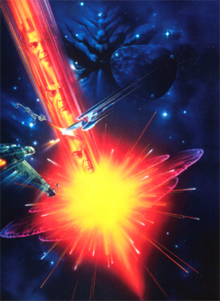Star Trek VI: The Undiscovered Country
| Star Trek VI: The Undiscovered Country | |
|---|---|

Theatrical release poster artwork by John Alvin
|
|
| Directed by | Nicholas Meyer |
| Produced by | |
| Screenplay by |
|
| Based on |
Star Trek by Gene Roddenberry |
| Starring | |
| Music by | Cliff Eidelman |
| Cinematography | Hiro Narita |
| Edited by | Ronald Roose William Hoy |
| Distributed by | Paramount Pictures |
|
Release date
|
|
|
Running time
|
110 minutes |
| Country | United States |
| Language | English |
| Budget | $27 million |
| Box office | $96.9 million |
Star Trek VI: The Undiscovered Country is a 1991 American science fiction film released by Paramount Pictures. It is the sixth feature film based on Star Trek, and a sequel to the 1966–1969 Star Trek television series. Taking place after the events of Star Trek V: The Final Frontier, it is the last film featuring the entire cast of the original series. After the destruction of the Klingon moon Praxis leads the Klingon Empire to pursue peace with their long-time adversary the Federation, the crew of the USS Enterprise must race against unseen conspirators with a militaristic agenda.
The sixth film in the series was initially planned as a prequel to the original series, with younger actors portraying the crew of the Enterprise while attending Starfleet Academy, but the idea was discarded because of negative reaction from the original cast and the fans. Faced with producing a new film in time for Star Trek's 25th anniversary, Nicholas Meyer, the director of Star Trek II: The Wrath of Khan, and Denny Martin Flinn wrote a script based on a suggestion from Leonard Nimoy about what would happen if "the Wall came down in space", touching on the contemporary events of the Cold War.
Principal photography took place between April and September 1991. The production budget was smaller than anticipated because of the critical and commercial disappointment of The Final Frontier. Because of a lack of sound stage space on the Paramount lot, many scenes were filmed around Hollywood. Meyer and cinematographer Hiro Narita aimed for a darker and more dramatic mood, subtly altering sets originally used for the television series Star Trek: The Next Generation. Producer Steven-Charles Jaffe led a second unit that filmed on an Alaskan glacier that stood in for a Klingon gulag. Cliff Eidelman produced the film's score, which is intentionally darker than previous Star Trek offerings.
...
Wikipedia
